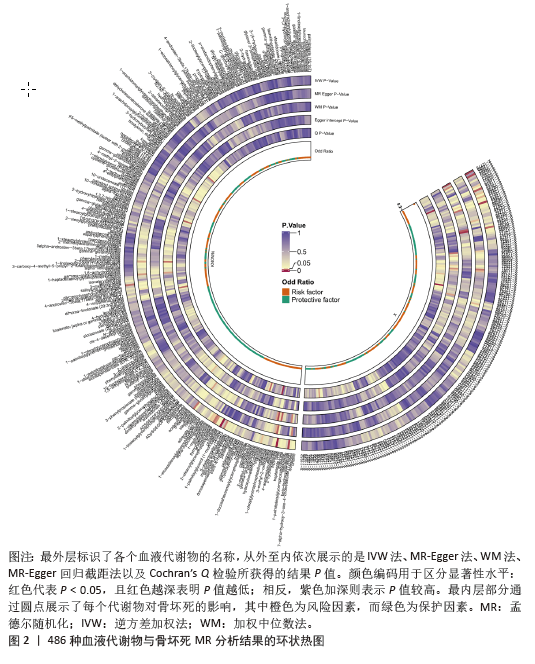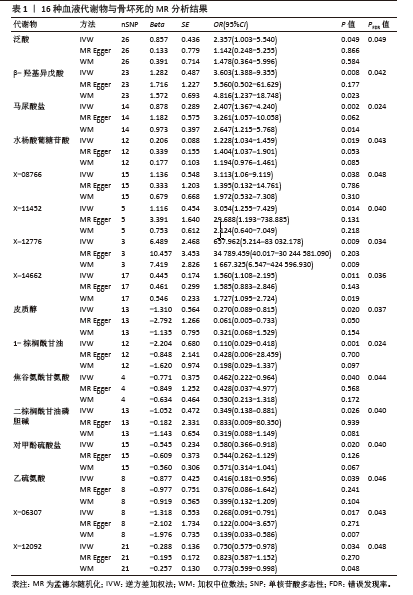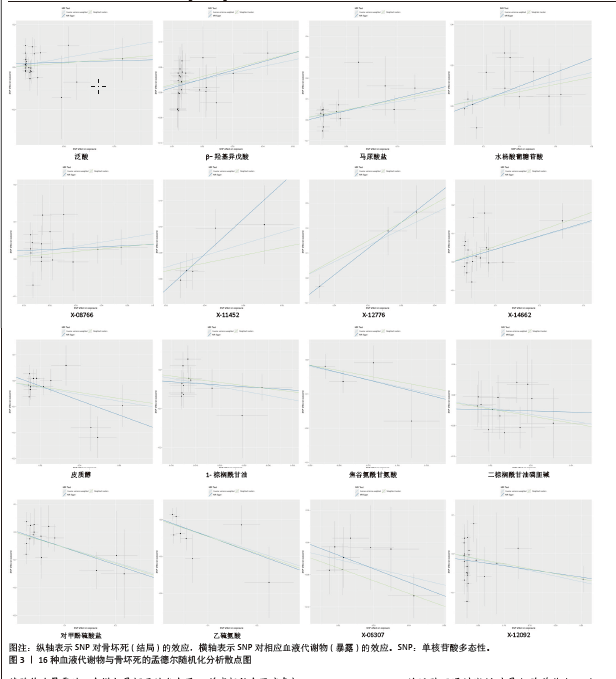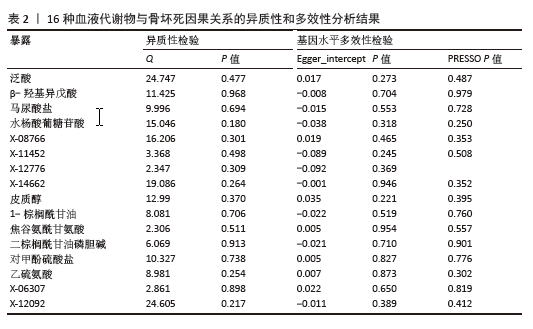[1] CHANG C, GREENSPAN A, GERSHWIN ME. The pathogenesis, diagnosis and clinical manifestations of steroid-induced osteonecrosis. J Autoimmu. 2020;110:102460.
[2] WANG X, HU L, WEI B, et al. Regenerative therapies for femoral head necrosis in the past two decades: a systematic review and network meta-analysis. Stem Cell Res Ther. 2024;15(1):21.
[3] LOU P, ZHOU G, WEI B, et al. Bone grafting for femoral head necrosis in the past decade: a systematic review and network meta-analysis. Int J Surg. 2023;109(3):412-418.
[4] ABU-SHAKRA M, BUSKILA D, SHOENFELD Y. Osteonecrosis in patients with SLE. Clin Rev Allergy Immunol. 2003;25:13-23.
[5] MURPHEY MD, FOREMAN KL, KLASSEN-FISCHER MK, et al. From the radiologic pathology archives imaging of osteonecrosis: radiologic-pathologic correlation. Radiographics. 2014;34(4):1003-1028.
[6] LI W, LI W, ZHANG W, et al. Exogenous melatonin ameliorates steroid-induced osteonecrosis of the femoral head by modulating ferroptosis through GDF15-mediated signaling. Stem Cell Res Ther. 2023; 14(1):171.
[7] QIU S, CAI Y, YAO H, et al. Small molecule metabolites: discovery of biomarkers and therapeutic targets. Signal Transduct Target Ther. 2023;8(1):132.
[8] LIU X, LI Q, SHENG J, et al. Unique plasma metabolomic signature of osteonecrosis of the femoral head. J Orthop Res. 2016;34(7): 1158-1167.
[9] GUO MK, ZHANG J. Metabolomic analysis of bone-derived exosomes in osteonecrosis of the femoral head based on UPLC–MS/MS. Metabolomics. 2023;19(4):34.
[10] PEREIRA TCS, SOUZA AR, DALTRO PB, et al. Blood plasma and bone marrow interstitial fluid metabolomics of sickle cell disease patients with osteonecrosis: An exploratory study to dissect biochemical alterations. Clin Chim Acta. 2023;539:18-25.
[11] AU YEUNG SL, GILL D. Standardizing the reporting of Mendelian randomization studies. BMC Med. 2023;21(1):187.
[12] FERENCE BA, HOLMES MV, SMITH GD. Using Mendelian randomization to improve the design of randomized trials. Cold Spring Harb Perspect Med. 2021;11(7):a040980.
[13] DAVIES NM, HOLMES MV, SMITH GD. Reading Mendelian randomisation studies: a guide, glossary, and checklist for clinicians. BMJ. 2018;362:k601.
[14] SHIN SY, FAUMAN EB, PETERSEN AK, et al. An atlas of genetic influences on human blood metabolites. Nat Genet. 2014;46(6):543-550.
[15] ZENG X, ZHONG B. Investigating the causal relationship between human blood metabolites and pulmonary hypertension: a two-sample Mendelian randomization study. Front Cardiovasc Med. 2024;11:1304986.
[16] LI P, WANG H, GUO L, et al. Association between gut microbiota and preeclampsia-eclampsia: a two-sample Mendelian randomization study. BMC Med. 2022;20(1):443.
[17] CAO Y, LU H, XU W, et al. Gut microbiota and Sjögren’s syndrome: A two-sample Mendelian randomization study. Front Immunol. 2023;14: 1187906.
[18] XU J, ZHANG S, TIAN Y, et al. Genetic causal association between iron status and osteoarthritis: a two-sample mendelian randomization. Nutrients. 2022;14(18):3683.
[19] WANG C, ZHU Y, PAN D. Identifying the causal relationship between immune factors and osteonecrosis: a two-sample Mendelian randomization study. Sci Rep. 2024;14(1): 9371.
[20] LI W, XU JW, CHAI JL, et al. Complex causal association between genetically predicted 731 immunocyte phenotype and osteonecrosis: a bidirectional two-sample Mendelian randomization analysis. Int J Surg. 2024;110(6):3285-3293.
[21] CHEN S, LIU J, ZHANG N, et al. Exploring of exosomes in pathogenesis, diagnosis and therapeutic of osteonecrosis of the femoral head: the mechanisms and signaling pathways. Biomed Mater. 2024;19(5):052006.
[22] EHMKE TA, CHERIAN JJ, WU ES, et al. Treatment of osteonecrosis in systemic lupus erythematosus: a review. Curr Rheumatol Rep. 2014;16:1-9.
[23] ÁLVAREZ-CÓRDOBA M, FERNÁNDEZ KHOURY A, VILLANUEVA-PAZ M, et al. Pantothenate rescues iron accumulation in pantothenate kinase-associated neurodegeneration depending on the type of mutation. Mol Neurobiol. 2019;56:3638-3656.
[24] MA Q, LIANG M, TANG X, et al. Vitamin B5 inhibit RANKL induced osteoclastogenesis and ovariectomy induced osteoporosis by scavenging ROS generation. Am J Transl Res. 2019;11(8):5008.
[25] ZHAO G, ZHONG H, RAO T, et al. Metabolomic analysis reveals that the mechanism of astaxanthin improves the osteogenic differentiation potential in bone marrow mesenchymal stem cells. Oxid Med Cell Longev. 2020;2020(1):3427430.
[26] SABOURIN PJ, BIEBER LL. Formation of β-hydroxyisovalerate by an α-ketoisocaproate oxygenase in human liver. Metabolism.1983;32(2):160-164.
[27] MOCK DM, STRATTON SL, HORVATH TD, et al. Urinary excretion of 3-hydroxyisovaleric acid and 3-hydroxyisovaleryl carnitine increases in response to a leucine challenge in marginally biotin-deficient humans. J Nutr. 2011;141(11): 1925-1930.
[28] MANJARÍN R, BOUTRY-REGARD C, SURYAWAN A, et al. Intermittent leucine pulses during continuous feeding alters novel components involved in skeletal muscle growth of neonatal pigs. Amino Acids. 2020; 52(9):1319-1335.
[29] LI W, DONG H, NIU K, et al. Analyzing urinary hippuric acid as a metabolic health biomarker through a supramolecular architecture. Talanta. 2024;278:126480.
[30] NAM M, HUH JE, KIM MS, et al. Metabolic alterations in the bone tissues of aged osteoporotic mice. Sci Rep. 2018;8(1):8127.
[31] XU M, MOTOMURA G, UTSUNOMIYA T, et al. Effects of bone mineral density at the lateral sclerotic boundary on the femoral head collapse onset in osteonecrosis of the femoral head: A preliminary study. Clin Biomech (Bristol). 2024;111:106156.
[32] LEI ZHU, ZHAO ZJ, REN XB, et al. Serum metabonomics of articular cartilage destruction induced by T-2 toxin in Wistar rats. Biomed Environ Sci. 2018;31(1):76-80.
[33] LI JP, GUO JM, SHANG EX, et al. Quantitative determination of five metabolites of aspirin by UHPLC–MS/MS coupled with enzymatic reaction and its application to evaluate the effects of aspirin dosage on the metabolic profile. J Pharm Biomed Anal. 2017;138: 109-117.
[34] DU M, PAN W, DUAN X, et al. Lower dosage of aspirin promotes cell growth and osteogenic differentiation in murine bone marrow stromal cells. J Dent Sci. 2016;11(3):315-322.
[35] PARK JS, HONG HS. FGF2/HGF priming facilitates adipose-derived stem cell-mediated bone formation in osteoporotic defects. Heliyon. 2024;10(2):e24554.
[36] DUAN P, YU YL, CHENG YN, et al. Exosomal miR-1a-3p derived from glucocorticoid-stimulated M1 macrophages promotes the adipogenic differentiation of BMSCs in glucocorticoid-associated osteonecrosis of the femoral head by targeting Cebpz. J Nanobiotechnology. 2024;22(1):648.
[37] TE WINKEL ML, PIETERS R, WIND EJD, et al. Management and treatment of osteonecrosis in children and adolescents with acute lymphoblastic leukemia. Haematologica. 2014;99(3):430.
[38] LIU J, HUANG X, LV T, et al. Intra-articular injection of chitosan combined with low-dose glucocorticoid for the treatment of knee osteoarthritis in early and middle stages. Medicine (Baltimore). 2024;103(40):e39924.
[39] NIU L, LI W, CHEN X, et al. 1‐Monopalmitin promotes lung cancer cells apoptosis through PI3K/Akt pathway in vitro. Environ Toxicol. 2023;38(11):2621-2631.
[40] LIN C, JIANG H, LOU C, et al. Asiatic acid prevents glucocorticoid-induced femoral head osteonecrosis via PI3K/AKT pathway. Int Immunopharmacol. 2024;130:111758.
[41] HUANG LK, ZENG XS, JIANG ZW, et al. Echinacoside alleviates glucocorticoid induce osteonecrosis of femoral head in rats through PI3K/AKT/FOXO1 pathway. Chem Biol Interact. 2024;391:110893.
[42] YAN Y, YU Y, LIU J, et al. Lipid metabolism analysis for peripheral blood in patients with alcohol-induced and steroid-induced osteonecrosis of the femoral head. Zhong Nan Da Xue Xue Bao Yi Xue Ban. 2022;47(7):872-880.
[43] GAY CV, GILMAN VR, SUGIYAMA T. Perspectives on osteoblast and osteoclast function. Poult Sci. 2000;79(7):1005-1008.
[44] LONG X, ZHANG Y, LIU M, et al. Causality of genetically determined blood metabolites on inflammatory bowel disease: a two-sample Mendelian randomization study. Sci Rep. 2024; 14(1):16361.
[45] YAN H, ZHAO S, HUANG HX, et al. Systematic Mendelian randomization study of the effect of gut microbiome and plasma metabolome on severe COVID-19. Front Immunol. 2023;14: 1211612.
[46] TABE S, HIKIJI H, HASHIDATE‐YOSHIDA T, et al. The role of lysophosphatidylcholine acyltransferase 2 in osteoblastic differentiation of C2C12 cells. FEBS Open Bio. 2024;14(9): 1490-1502.
[47] ZHANG B, HE W, PEI Z, et al. Plasma proteins, circulating metabolites mediate causal inference studies on the effect of gut bacteria on the risk of osteoporosis development. Ageing Res Rev. 2024;101:102479.
[48] GRYP T, VANHOLDER R, VANEECHOUTTE M, et al. p-Cresyl sulfate. Toxins (Basel). 2017;9(2):52.
[49] LUBKOWICZ D, HAVA DL, LEWIS K, et al. Rational Engineering of Escherichia coli Nissle 1917 as Live Biotherapeutic to Degrade Uremic Toxin Precursors. ACS Synth Biol. 2024;13(4):1077-1084.
[50] WYPYCH TP, PATTARONI C, PERDIJK O, et al. Microbial metabolism of L-tyrosine protects against allergic airway inflammation. Nat Immunol. 2021;22(3):279-286.
[51] BRIAL F, ALZAID F, SONOMURA K, et al. The natural metabolite 4-cresol improves glucose homeostasis and enhances β-cell function. Cell Rep. 2020;30(7):2306-2320. e5.
[52] YAN Y, WANG J, HUANG D, et al. Plasma lipidomics analysis reveals altered lipids signature in patients with osteonecrosis of the femoral head. Metabolomics. 2022;18(2):14.
[53] BAEK SH, KIM KH, LEE WK, et al. Abnormal lipid profiles in nontraumatic osteonecrosis of the femoral Head: a comparison with osteoarthritis using propensity score matching. J Bone Joint Surg Am. 2022;104(Suppl 2):19-24.
[54] JIA D, ZHANG Y, LI H, et al. Predicting steroid-induced osteonecrosis of the femoral head: role of lipid metabolism biomarkers and radiomics in young and middle-aged adults. J Orthop Surg Res. 2024;19(1):749.
[55] THOMAS TA, FRANCIS RO, ZIMRING JC, et al. The Role of Ergothioneine in Red Blood Cell Biology: A Review and Perspective. Antioxidants (Basel). 2024;13(6):717.
[56] FU TT, SHEN L. Ergothioneine as a natural antioxidant against oxidative stress-related diseases. Front Pharmacol. 2022;13:850813.
[57] SAKATA S, KUNIMATSU R, TANIMOTO K. Protective Effect of Ergothioneine against Oxidative Stress-Induced Chondrocyte Death. Antioxidants (Basel). 2024;13(7):800.
[58] YANG Y, JIAN Y, LIU Y, et al. Mitochondrial maintenance as a novel target for treating steroid-induced osteonecrosis of femoral head: a narrative review. EFORT Open Rev .2024;9(11):1013-1022.
[59] CHEN K, LIU Y, HE J, et al. Steroid-induced osteonecrosis of the femoral head reveals enhanced reactive oxygen species and hyperactive osteoclasts. Int J Biol Sci. 2020;16(11):1888.
[60] ZHANG X, FENG C, YUAN T, et al. Inhibition of protein disulfide isomerase mitigates steroid-induced osteonecrosis of the femoral head by suppressing osteoclast activity through the reduction of cellular oxidative stress. Chem Biol Interact. 2024;404:111263. |




